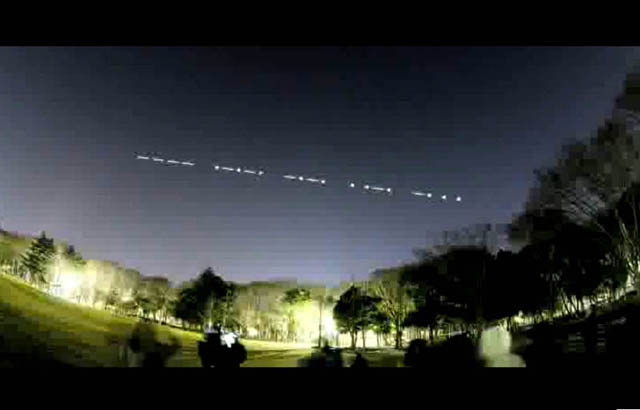
****DEDICADA EXCLUSIVAMENTE A LA RADIOAFICION POR SATELITE DESDE VENEZUELA POR EL MUNDO Y PARA EL MUNDO Y A LA ****ENSEÑANZA Y DIVULGACION DEL AMBITO DIGITAL, SATELITAL Y LA ISS. GRUPO CREADO EL 26 DE DICIEMBRE DE 2009 EN YAHOO.GROUPS, PARA COMPARTIR CONOCIMIENTOS A LA RADIOAFICION. Autor: Manuel Mosquera Ramírez YV5MM Miembro del Radio Club Venezolano # 1347 desde el año 1970 y Asociación de Radioaficionados de Venezuela MIEMBRO PRINCIPAL desde el 18 de Mayo de 1970
WELCOME TO YV-SAT GROUP - BIENVENIDOS AL GRUPO YV-SAT
domingo, 21 de octubre de 2012
lunes, 10 de septiembre de 2012
ISS AMATEUR RADIO CUBESAT DEPLOYMENT POSTPONED
ISS Amateur Radio CubeSat deployment postponed
JAXA have announced that the deployment of five CubeSats from the International Space Station (ISS) planned for September 10 has been postponed due to an additional EVA taking place September 5. A new deployment date has not yet been announced.Four of the CubeSats carry Amateur Radio payloads, they are F-1, FITSAT-1, WE-WISH and TechEdSat.
The small satellites, just 10cm cubed, were transported to the ISS in the HTV-3 cargo vessel that blasted off on an H-IIB rocket from the Tanegashima Space Center on Saturday, July 21 at 02:06 UT.
They arrived at the ISS on July 27 and were unloaded by the Expedition 32 crew.
The CubeSats are mounted in a JEM-Small Satellite Orbital Deployer (J-SSOD). In one pod are FITSAT-1, TechEdSat and F-1 and in the second pod is WeWish and a scientific 2U CubeSat RAIKO. Japanese astronaut Akihiko Hoshide KE5DNI will use the ISS Kibo robot arm to deploy the pods as demonstrated in this video.
Watch the planned deployment of the CubeSats from the ISS
The CubeSat frequencies are:
F-1
http://fspace.edu.vn/?page_id=10
On-board camera for earth observation mission
Yaesu VX-3R 1, 437.485 MHz FM downlink:
o Solar cell power only, operates in sunlight only
o Output power: between 0.1W and 0.3W depending on illumination, half-wave dipole antenna
o Morse code beacon (10 chars) using FM CW every 30 seconds, listen here
Yaesu VX-3R 2, 145.980 MHz FM downlink:
o Rechargeable battery, operates in dark and sunlight
o Output power: max 1.0W, half-wave dipole antenna
o AFSK 1200bps, half duplex, one AX.25 packet every 60 seconds
WE WISH
http://www.meisei.co.jp/news/2011/0617_622.html
Infrared camera for environmental studies
Telemetry downlink on 437.505 MHz
FITSat 1
http://www.fit.ac.jp/~tanaka/fitsat.shtml
High-speed data test, high power LED visual tracking
CW Beacon 437.250 MHz,
FM Data 437.445 MHz,
High speed data 5840.00 MHz.
TechEdSat
http://ncasst.org/techedsat.html
Telemetry downlink on 437.465 MHz. It is also carrying SatPhone ground station hardware and will use it communicate via the Iridium and Orbcomm satellite phone networks, a first for a CubeSat.
RAIKO – the only non-amateur radio CubeSat
http://tinyurl.com/RAIKO-CubeSat (Google English)
2U CubeSat, photography, Ku-band beacon
Manuel Mosquera Ramirez
YV5MM / 4M6M / YW6ISS
P.O. Box 20285
Caracas 1020A D.C.
yv5mm@amsat.org
yv5mm6@gmail.com
www.flickr.com/photos/yv5mm/
www.flickr.com/photos/yv5mm/
Google: YV5MM
miércoles, 8 de agosto de 2012
lunes, 6 de agosto de 2012
sábado, 4 de agosto de 2012
sábado, 28 de julio de 2012
FITSAT-1
Este texto, sobre el conocido y esperado CUBESAT, lo recibí de Alberto - LU1DZ:



Un proyecto originario de Japon incluye la puesta en
orbita de un pequeño satelite destinado al estudio de las comunicaciones opticas
entre estaciones de navegacion espacial.
Se trata de un CUBESAT denominado FITSAT-1 (NIWAKA) http://www.fit.ac.jp/~tanaka/fitsat.shtml que utilizando la tecnica de LEDs emitira señales luminosas pulsantes de 200W en Codigo Morse las que se podrian visualizar durante el periodo nocturno.
Se trata de un CUBESAT denominado FITSAT-1 (NIWAKA) http://www.fit.ac.jp/~tanaka/fitsat.shtml que utilizando la tecnica de LEDs emitira señales luminosas pulsantes de 200W en Codigo Morse las que se podrian visualizar durante el periodo nocturno.
El Profesor Takushi Tanaka http://www.fit.ac.jp/~tanaka/ director
del proyecto, remarca que sera posible observar las señales de Morse a simple
vista sin necesidad de ninguna ayuda y que una vez en orbita el NIWAKA navegara
entre los 51 6 ° de latitud Sur y los 51 6° de latitud Norte.
El FITSAT-1 y la estacion terrena utilizando telescopios
especiales llevaran a cabo experimentos de comunicacion en Morse de alta
velocidad entre ambos puntos con 3 minutos de duracion.
Asi mismo se efectuara una experiencia de comunicaciones
en 5,8 GHz y llevara un beacon de 430 MHz. de CW comenzando en Morse
internacional con HI y una serie de 18 parametros de medicion y tambien emitira
en Packet AX25 a 1200 Baudios.
73,
Edwin - YV5EN (antes YV5HUJ)
lunes, 16 de julio de 2012
sábado, 7 de julio de 2012
miércoles, 6 de junio de 2012
viernes, 1 de junio de 2012
viernes, 4 de mayo de 2012
viernes, 13 de abril de 2012
lunes, 9 de abril de 2012
lunes, 2 de abril de 2012
martes, 27 de marzo de 2012
domingo, 25 de marzo de 2012
jueves, 22 de marzo de 2012
miércoles, 22 de febrero de 2012
lunes, 9 de enero de 2012
Space Station Flying by the Moon
Space Station Flying by the Moon
 |
| LA ESTACION ESPACIAL INTERNACIONAL - FOTO DE COLECCION DE LA NASA - TOMADA DESDE HOUSTON, TEXAS. U.S.A |
sábado, 7 de enero de 2012
INTERNATIONAL SPACE STATION PACKET FROM ANACO, VENEZUELA FJ79SK - YW6ISS -
miércoles, 4 de enero de 2012
UNIDOS POR LA RADIO: PRIMER ANIVERSARIO GRUPO UNIDOS POR LA RADIO
UNIDOS POR LA RADIO: PRIMER ANIVERSARIO GRUPO UNIDOS POR LA RADIO: PRIMER ANIVERSARIO GRUPO UNIDOS POR LA RADIO BASES Conmemorando EL PRIMER ANIVERSARIO DEL GRUPO UNIDOS POR LA RADIO. Este grupo, agradec...
Suscribirse a:
Comentarios (Atom)



